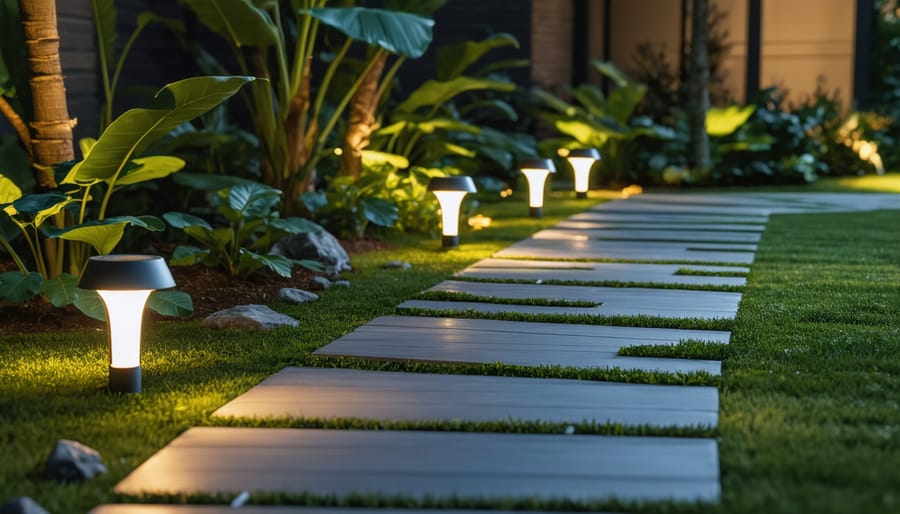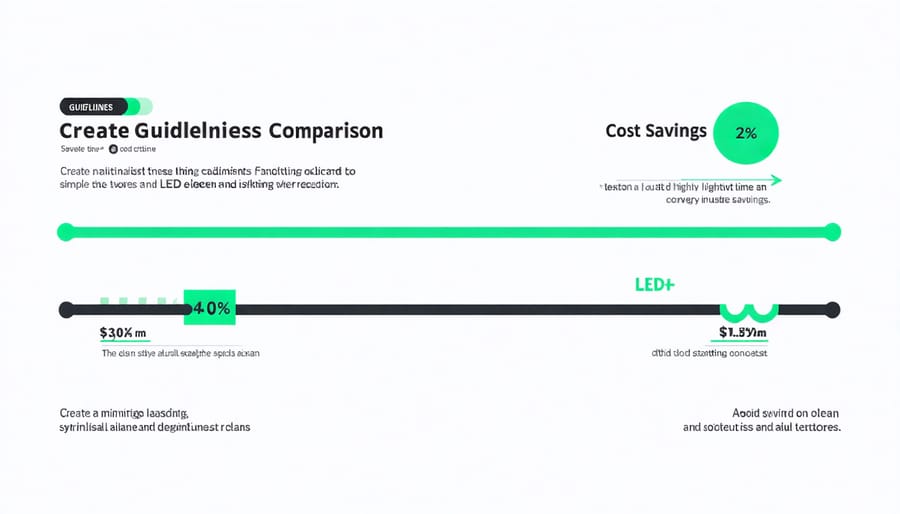Transform your outdoor lighting into an environmental asset by choosing solar-powered LED fixtures that automatically adjust brightness based on ambient light levels. Install motion sensors and timers on essential pathway lights to reduce unnecessary power consumption while maintaining security. Position energy-efficient spotlights strategically near gathering areas in your eco-friendly outdoor spaces to maximize illumination with minimal fixtures. Replace traditional high-wattage floodlights with warm-toned, low-voltage LED systems that reduce light pollution and protect nocturnal wildlife.
Modern outdoor lighting doesn’t have to choose between beauty and sustainability. Energy-efficient illumination technologies have evolved dramatically, offering solutions that slash electricity costs by up to 80% while creating stunning nighttime landscapes. Whether you’re lighting a cozy patio or securing a sprawling yard, today’s eco-conscious options deliver powerful performance without compromising our planet’s resources.
The Environmental Impact of Traditional Outdoor Lighting
Light Pollution: More Than Just Blocked Stars
Light pollution is more than just a nuisance that blocks our view of the starry night sky. When artificial light spills into natural environments, it disrupts the delicate balance of local ecosystems. Nocturnal animals, which make up about 60% of all mammals, struggle to hunt, mate, and navigate when their dark environment is artificially brightened.
This excessive artificial lighting also confuses migratory birds, causing them to veer off course or collide with illuminated buildings. Sea turtle hatchlings, naturally drawn to the moonlight reflecting off the ocean, often become disoriented by artificial lights and crawl inland instead of toward the sea.
For humans, light pollution can disrupt our natural sleep-wake cycle, known as the circadian rhythm. Exposure to artificial light at night suppresses melatonin production, making it harder to get quality sleep. This disruption has been linked to various health issues, including increased risk of depression, obesity, and certain types of cancer.
The good news is that by choosing thoughtful outdoor lighting solutions, we can help minimize these impacts while still maintaining safe and beautiful outdoor spaces.

Energy Waste in Common Outdoor Fixtures
Traditional outdoor lighting fixtures can be surprising energy guzzlers, often consuming more power than necessary for their intended purpose. A typical 100-watt floodlight left on for 12 hours each night adds up to roughly 438 kilowatt-hours annually – that’s enough energy to run a refrigerator for two months!
Many older outdoor fixtures use inefficient incandescent or halogen bulbs, which convert only 10% of their energy into light while the remaining 90% is lost as heat. Motion-activated security lights are often set with too high wattage and excessive sensitivity, triggering unnecessarily throughout the night.
Decorative path lights and garden fixtures can be particularly wasteful when poorly planned. Using multiple high-wattage fixtures where fewer, more efficient ones would suffice is a common mistake. Additionally, poorly positioned lights that illuminate the sky rather than the intended area waste energy and contribute to light pollution.
Timer-controlled systems, when improperly set, may run longer than needed, especially during summer months when natural daylight extends into later hours. These inefficiencies not only impact the environment but also significantly increase your energy bills.
Modern Eco-Friendly Lighting Solutions
Solar-Powered Lighting Systems
Harnessing the power of the sun, solar-powered garden lighting offers an eco-friendly and cost-effective solution for illuminating your outdoor spaces. These systems typically consist of solar panels, rechargeable batteries, LED bulbs, and light sensors that work together seamlessly to provide reliable lighting from dusk till dawn.
Modern solar lights come in various styles and serve multiple purposes. From pathway markers and security flood lights to decorative string lights and post caps, there’s an option for every lighting need. The best part? Installation is usually as simple as pushing a stake into the ground or mounting a bracket – no complex wiring or electrical expertise required.
To get the most from your solar lights, position the panels where they’ll receive maximum sunlight during the day. South-facing installations typically work best in the Northern hemisphere. Most units automatically turn on at dusk and off at dawn, though some models offer customizable timing and brightness settings.
While initial costs might be slightly higher than traditional lighting, solar-powered systems quickly pay for themselves through eliminated electricity bills and minimal maintenance needs. Today’s solar lights can last for years, with only occasional battery replacement needed. Plus, many models now feature motion sensors and remote controls, adding convenience while maintaining their eco-friendly benefits.

LED Technology Innovations
LED technology has revolutionized outdoor lighting, offering an impressive combination of energy efficiency and smart features that make it perfect for eco-conscious homeowners. Today’s LED bulbs use up to 75% less energy than traditional lighting while lasting up to 25 times longer, making them a fantastic investment for your outdoor spaces.
Modern LED options come in various color temperatures, from warm white that creates a cozy ambiance to daylight tones that provide crystal-clear visibility. Many fixtures now include built-in motion sensors and daylight detection, automatically adjusting brightness based on natural light levels and activity around your home.
Smart LED systems take efficiency even further, allowing you to control your outdoor lighting from your smartphone. You can set schedules, create lighting zones, and even change colors for different occasions. Some systems even learn your habits over time, optimizing energy usage without sacrificing functionality.
What’s particularly exciting is the advancement in solar-powered LED lights. These combine the efficiency of LED technology with renewable energy, creating a truly sustainable lighting solution. Many models now include improved battery storage, ensuring reliable performance even during cloudy periods.
When choosing LED outdoor lights, look for fixtures with high IP ratings for weather resistance and check the lumens rather than watt equivalency to ensure you’re getting the right brightness for your needs. The initial cost might be higher than traditional bulbs, but the long-term energy savings and reduced maintenance make LEDs an environmentally and financially smart choice.
Motion Sensors and Smart Controls
One of the most effective ways to reduce energy consumption in outdoor lighting is through the integration of motion sensors and smart outdoor lighting solutions. These intelligent systems ensure your lights are only active when needed, significantly cutting down on unnecessary energy use while maintaining security and functionality.
Motion sensors work by automatically activating lights when they detect movement within their range. This means your pathway lights or security fixtures only illuminate when someone approaches, rather than staying on all night. Most modern sensors can be adjusted for sensitivity and duration, allowing you to customize settings based on your specific needs.
Smart controls take this automation a step further by offering features like scheduling, remote operation through smartphone apps, and even integration with other home automation systems. You can set your lights to turn on at sunset and off at sunrise, or create custom schedules that align with your routine. Some systems even use geofencing technology to activate lights when you’re approaching home.
The real beauty of these automated solutions lies in their set-and-forget nature. Once properly configured, they’ll handle all the work of managing your outdoor lighting, ensuring optimal energy efficiency without compromising on safety or convenience. Plus, many modern systems can even learn from your usage patterns and adjust automatically, making them even more efficient over time.
Installation and Placement Tips
Strategic Positioning for Maximum Efficiency
Smart positioning of your outdoor lights isn’t just about creating ambiance – it’s about maximizing efficiency while minimizing energy waste. Start by mapping out your outdoor space and identifying key areas that need illumination, like pathways, entryways, and security zones.
Position motion sensors strategically at entry points and high-traffic areas. This ensures lights only activate when needed, significantly reducing unnecessary power consumption. For pathways, place lights at intervals of 6-8 feet, staggering them on alternating sides to provide even coverage without overlap.
When lighting larger areas, opt for fewer, well-placed bright lights rather than multiple dim ones. Mount fixtures higher up for broader coverage – this reduces the total number of lights needed. For deck and patio areas, consider installing lights under railings or steps to maximize their functionality while keeping them protected from the elements.
Don’t forget about natural light interaction. Position your fixtures away from existing light sources like street lamps to avoid redundancy. Use timers to coordinate with sunset and sunrise, ensuring lights aren’t running when natural light is sufficient.
For accent lighting on landscaping features, angle lights upward at 45 degrees to minimize light pollution while maximizing visual impact. Remember to adjust seasonal timing as daylight hours change, and regularly clean your fixtures to maintain optimal performance.
These strategic placement tips help create an efficient lighting system that serves its purpose while keeping energy consumption in check.
DIY Installation Guidelines
Ready to transform your outdoor space with eco-friendly lighting? Follow these simple steps to install your sustainable lighting solutions safely and effectively.
1. Plan Your Layout
Start by mapping out your lighting placement on paper. Consider high-traffic areas, safety requirements, and focal points you’d like to highlight. Mark underground utilities before digging to avoid any accidents.
2. Solar Path Lights Installation
– Choose a sunny location
– Remove grass or debris from installation spots
– Push stakes firmly into soft ground
– Ensure solar panels face south for maximum exposure
– Space lights 6-8 feet apart for optimal coverage
3. Motion Sensor Lights
– Turn off power at the circuit breaker
– Mount the light fixture at the recommended height (usually 6-8 feet)
– Connect wires according to manufacturer instructions
– Adjust sensor sensitivity and timer settings
– Test the motion detection range
4. String Light Installation
– Install mounting points (hooks or guide wire)
– Measure and plan slack for wind movement
– Use UV-resistant zip ties or clips
– Connect to a timer or smart plug for automated control
– Secure loose cables neatly
Pro Tips:
– Install lights on a cloudy day to better judge lighting effectiveness
– Use waterproof connectors for all outdoor wiring
– Consider installing a photocell sensor to automate operation
– Keep maintenance access in mind during installation
– Double-check all connections before final setup
Remember to always follow local building codes and manufacturer instructions for safe installation. When in doubt, consult a licensed electrician.
Maintenance and Long-term Benefits
Care and Upkeep
Regular maintenance of your eco-friendly outdoor lighting not only extends its lifespan but also ensures optimal performance. For solar-powered lights, clean the panels monthly with a soft, damp cloth to remove dust and debris that can reduce charging efficiency. During winter months, brush off any snow accumulation to maintain consistent power collection.
LED fixtures should be inspected quarterly for any signs of water damage or loose connections. While these lights are incredibly durable, checking the seals and housings helps prevent moisture-related issues. Gently clean the fixtures with a mild soap solution and soft cloth to maintain their brightness.
For motion sensor lights, test the sensitivity settings every few months and adjust as needed. Clean the sensor eye regularly to ensure proper function. In areas with heavy foliage, trim back any branches or leaves that might trigger false activations or block the sensor.
Keep an eye on your timer settings throughout the year, adjusting them with the changing seasons to maximize efficiency. For ground-mounted lights, check that soil hasn’t shifted to cover any parts of the fixture, and clear away any encroaching vegetation.
Store any removable solar lights indoors during extreme weather conditions to protect their batteries and extend their service life.
Cost Savings Analysis
Making the switch to eco-friendly outdoor lighting isn’t just good for the planet – it’s also a smart financial move that can significantly reduce your energy bills over time. Let’s break down the numbers to see just how much you can save.
Traditional incandescent outdoor bulbs typically consume around 60-100 watts per bulb, while their LED counterparts use only 7-20 watts while providing the same brightness. For a typical home with 6 outdoor lights running 6 hours nightly, switching to LEDs can save approximately $80-120 annually on electricity costs.
While eco-friendly lighting options might have a higher upfront cost (LED bulbs average $5-15 per bulb compared to $1-2 for incandescent), the investment typically pays for itself within 12-18 months. Solar-powered lights offer even greater savings, eliminating electricity costs entirely after the initial purchase.
The longevity of eco-friendly options adds to their value proposition. LED bulbs last 25,000-50,000 hours compared to just 1,000-2,000 hours for traditional bulbs, meaning fewer replacements and lower maintenance costs. When you factor in potential local energy rebates and incentives, the financial benefits become even more appealing.

As we’ve explored throughout this guide, eco-friendly outdoor lighting offers a perfect blend of sustainability, aesthetics, and functionality. By choosing solar-powered fixtures, LED bulbs, and motion sensors, you’re not just creating a beautiful outdoor space – you’re actively contributing to environmental conservation while reducing your energy bills.
Remember that small changes can make a big impact. Starting with just a few solar pathway lights or replacing old fixtures with energy-efficient alternatives can set you on the path to a more sustainable outdoor lighting setup. The investment in eco-friendly lighting solutions pays off through lower electricity costs and reduced maintenance needs, all while helping to preserve our planet’s resources.
Whether you’re illuminating a garden path, securing your property, or creating ambiance for outdoor entertaining, there’s an eco-friendly lighting solution that fits your needs. By implementing the tips and techniques we’ve discussed, you’ll create an outdoor space that’s both welcoming and environmentally responsible.
Take the first step today toward sustainable outdoor lighting. Your wallet – and the environment – will thank you for years to come.
